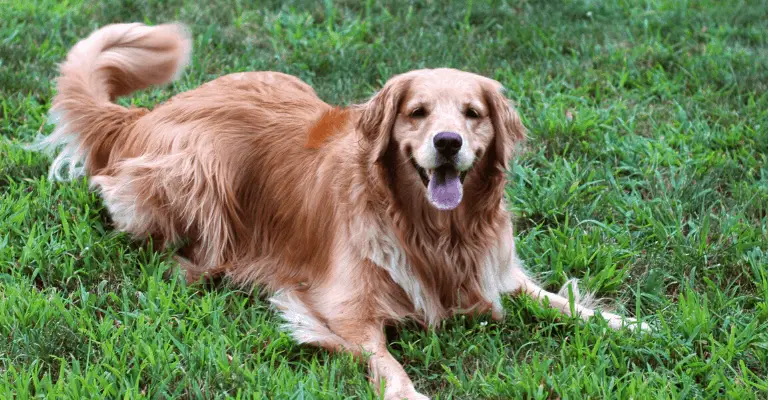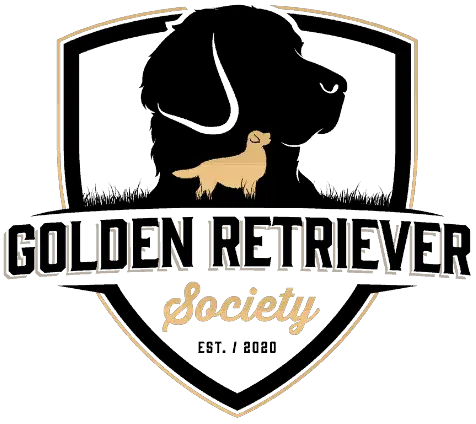When an owner brings their dog to me for a wellness visit, we discuss many common topics such as vaccine schedules, spaying and neutering, nutrition, and dental health. Even though there is a great deal of variation between breeds, hair coat discussions occur infrequently.
Coat care is extremely important to the health of all dogs, especially Golden Retrievers, and having knowledge about your Golden’s hair coat can make it much easier to maintain.
Table of Contents
Golden Retriever Coat Stages
Golden Retriever puppies are born with fluffy, fuzzy hair coats. This fur is very soft and fine, and it helps to keep puppies warm due to its insulating properties.
Golden puppies begin to grow adult hairs around three to four months of age, starting at the tail and then gradually moving up the body. These slightly coarser outer hairs are called guard hairs, and they push the puppy fur aside until the puppy fur forms an undercoat, which thickens over time. Guard hairs form the outer coat which gives a Golden Retriever his classic double-coat as an adult. This transition phase of hair growth usually finishes when he is about 18 months old.
Guard hairs tend to be slightly darker in color compared to the undercoat hairs. The thickness of the undercoat is affected by the changing of the seasons and how often your Golden Retriever spends time outdoors. Most Goldens also develop “feathers” which are very long, fine hairs that grow in specific locations like the backs of the legs and over the belly.
Golden Retriever Shedding Season
The typical Golden will shed his fur year-round, but his shedding will be at its heaviest during the late Spring and the late Fall. In the Spring, your furry friend is “blowing out” his heavy winter undercoat to make ready for the warmer months. A lighter undercoat forms in its place, and this lighter undercoat is then lost in the Fall to help make way for the thicker undercoat needed to deal with cooler temperatures.
In some cases, your dog’s shedding may be the result of a medical condition. If his excessive shedding is out of season, or if he is losing hair in large patches, you need to contact your veterinarian. The following medical conditions can result in abnormal hair loss for dogs.
- Endocrine disorder (hypothyroidism, Cushing’s disease)
- External parasites (fleas, mites)
- Fungal infection (ringworm)
- Bacterial infection
- Allergies (food, atopic)
Golden Retriever Coat Care

Brushing the Coat
Brushing is one of the best things that you can do for your pup. The sooner you start brushing, the quicker your Golden will get used to brushing as part of his regular routine. Use a soft brush for puppies and then gradually switch to a comb or stiff-bristled brush for your adult dog. Check out our article Best Dog Brushes for Golden Retrievers to find the right tool for the job you need.
Frequent brushing can help reduce shedding because it removes loose hairs and makes way for new, healthy hairs. Brushing also helps remove dead skin cells, thereby lowering the amount of dander that can accumulate around your home, and it helps distribute skin oils evenly along your dog’s hairs. And while hairballs don’t often occur in dogs, the regular removal of excess loose hairs can decrease the amount accidentally ingested during self-grooming.
Keeping the Coat Clean
Dogs with long hair coats can get small burrs, twigs, and leaves caught in their fur. These can become tangled in the fur and cause mats of hair which are sometimes difficult to remove. Be sure to check your Golden after each walk because it is easier to remove these items when they first become entrapped.
It is easier to remove burrs and twigs before a bath. Otherwise, bathing a tangled knot of hair can cause further entrapment! The average Golden can be bathed once every six to eight weeks. However, puppies that are prone to accidents and getting dirty may need to be bathed more often, no more frequently than twice a week. More frequent bathing can also help dogs during the height of shedding season. Be sure to use shampoo that is specifically formulated for dogs unless otherwise directed by your veterinarian.
Your Golden can benefit from trips to the grooming salon, especially if it is difficult for you to bathe him yourself. Groomers can also cut nails, clean ears, and trim hair coats. It is okay to have your dogs feathers trimmed, and groomers are equipped to remove mats that are close to the skin, but never have your dog’s hairs clipped shorter than an inch or two because it is necessary to have hairs to protect your dog’s skin from the sun.
Good Nutrition
Complete nutrition is critical to your dog’s skin and coat health. Many commercial dog diets are equipped with the right balance of nutrients such as proteins, carbohydrates, fats, fiber, vitamins, and minerals. Homemade diets are fine as long as they have been formulated by a veterinary behaviorist. There is no scientific evidence yet available that proves the benefits of a raw-food diet, and grain-free diets are currently under investigation by the FDA for a potential link between grain-free foods and dilated cardiomyopathy in Golden Retrievers.
As far as treats, be sure to read our article on Best Dog Treats For Golden Retrievers as we discuss the healthiest options for Goldens. Healthy treats are just as important as healthy food.
Vitamin E and omega-3 fatty acids like those found in fish oils are a few of the most important nutrients for a healthy hair coat. Vitamin E, which is found in commercial diets, is an antioxidant which helps protect against the oxidative damage to skin caused by external sources such as sunlight. Omega-3 fatty acids help contribute to natural skin oils and have an anti-inflammatory effect, making them especially useful in situations with skin allergies. Omega-3s are found in low quantities in most diets and so supplementation is sometimes necessary for full effect.
Conclusion
Golden Retrievers have a classic double-coat that starts out as a fine, fluffy coat until the guard hair layer develops. Shedding occurs year-round, but is most intense during the Spring and Fall seasons. It is influenced by environmental factors.
Routine bathing, grooming, and proper nutrition can keep your pup’s coat shiny and healthy, but if hair loss is a problem, consult your veterinarian in case your Golden has a health disorder. The sooner you act, the sooner you can get your Golden Retriever back to being happy and healthy!
Be sure to visit our Recommended Shampoo page to see what we use on our dogs to keep their coat looking beautiful.

